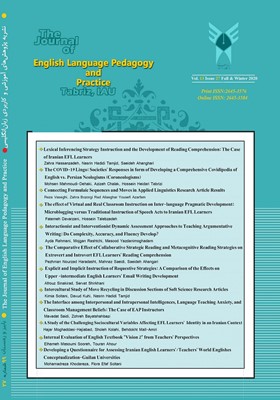نگرش زبان آموزان ایرانی نسبت به فرهنگ زبان های مقصد و مبدا
Subject Areas : آموزش زبان انگلیسیغلامرضا عباسیان 1 , مژگان کوه پایه زاده 2 , غلامرضا اصغرپور 3
1 - Imam Ali and Department of English, South Tehran Branch, Islamic Azad University, Tehran, Iran
2 - Department of English, South Tehran Branch, Islamic Azad University, Tehran, Iran
3 - Department of English, South Tehran Branch, Islamic Azad University, Tehran, Iran
Keywords: زبان مبدا, زبان مقصد, فرهنگ و زبان, نگرش زبان آموزان,
Abstract :
با توجه به ارتباط تنگاتنگ زبان و فرهنگ و وابسته بودن یادگیری زبان به یادگیری فرهنگ ، در این مطالعه تلاش شد تا نگرش زبان آموزان ایرانی رشته زبان انگلیسی دانشگاه آزاد اسلامی واحد جنوب تهران در مقاطع کارشناسی و کارشناسی ارشد نسبت به یادگیری جنبه های فرهنگی هر دو زبان مقصد و مبدا مورد بررسی قرار گیرد. در این راستا، پنجاه زبان آموز (25 نفر در مقطع کارشناسی و 25 نفر در مقطع کارشناسی ارشد) که به صورت تصادفی انتخاب شده بودن به سوالات یک پرسشنامه ناظر بر ارتباط با دیدگاه آنها نسبت به فرهنگ زبان های مقصد و مبدا (انگلیسی و فارسی) پاسخ دادند. سپس نتایج بدست آمده بر اساس آزمون خی مورد تجزیه و تحلیل شد که نتایج حاصله داد موید اهمیت فرهنگ هر دو زبان در فرایند یادگیری زبان دوم برای کلیه جامعه آماری می باشد. ضمنا، یافته های این مطالعه نشان داد که زبان آموزان در مقطع کارشناسی ارشد نسبت به زبان آموزان در مقطع کارشناسی تمایل بیشتری به یادگیری فرهنگ و زبان مقصد و مبدا دارند.
Akbari, R. (2008). Transforming lives: introducing critical pedagogy into ELT Classrooms. ELT journal, 62(3), 276-283.
Alptekin, C. (2002). Towards intercultural communicative competence in ELT. ELT Journal, 56(1), 57-64.
Brooks, N. (1975). The analysis of language and familiar cultures. In R. Lafayette (Ed.), the cultural revolution in foreign language teaching (pp. 19-31). Reports of the Northeast Conference on the Teaching of Foreign Languages. Lincolnwood, IL: National Textbook.
Byram, M. (1989). A school visit to France: Ethnographic explorations. British Journal of Language Teaching, 27, (2), 99-103.
Byram, M. (1997). Teaching and assessing intercultural communicative competence. London: Multilingual Matters.
Byram, M. (2000). Assessing intercultural competence in language teaching. Sprogforum, 18, 8-13.
Byram, M., Esarte-Sarries, Taylor, & Allatt. (1991). Young people’s perception of other cultures. In D. Buttjes & M. Byram (Eds.), Mediating languages andcultures (pp. 103-119). Clevedon, Avon, England: Multilingual Matters.
Corbett, J. (2003). An intercultural approach to English language teaching. Clevedon: Multilingual Matters.
Crawford-Lange, L. M. & Lange, D. (1984). Doing the unthinkable in the secondlanguage classroom: A process for integration of language and culture. InT. V. Higgs (Ed.), Proficiency: The organizing principle (pp.139-177). TheAmerican Council on the Teaching of Foreign Languages ForeignLanguage Education Series. Lincolnwood, IL: National Textbook.
Deardorff, D. K. (2006). Identification and assessment of intercultural competence as a student outcome of internationalization. Journal of Studies in International Education 10(3): 241-266.
Erfani, S. M., (2014). Source culture, Target Culture or Interculture? Iranian English Language Teachers‟ Perception of Culture. International Journal of Language Learning and Applied Linguistics World, 8(4).
Fantini, A.E. (2009). Assessing intercultural competence: Issues and tools. In D.K. Deardoff (Ed), Sage Handbook of Intercultural Competence. (456-477) Los Angeles: Sage.
Gray, J. (2000). The ELT coursebook as cultural artifact: How teachers censor and adapt. ELTJournal, 54 (3), 274-283.


